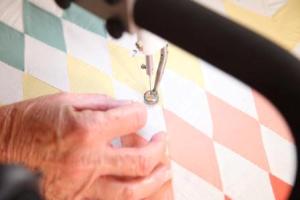How you can secure starts and stops
 For generations, quilters have used needles to bury the beginning and ending thread tails on their quilts. However, you may not need to use that extra effort, especially if you would be burying a dark thread inside a light quilt! Plan out some practice time and try your hand at these two methods
For generations, quilters have used needles to bury the beginning and ending thread tails on their quilts. However, you may not need to use that extra effort, especially if you would be burying a dark thread inside a light quilt! Plan out some practice time and try your hand at these two methods
Using the needle up/down feature on your machine
- Bring your bobbin thread to the top of the quilt using your needle up/down feature. Hold the two thread tails securely and take 2-3 very tiny stitches close together. Now tug on the thread tails to ensure that no thread loops appear on the back where you begin.
- Next, use the needle up/down feature to place many small stitches right next to each other, traveling in the direction you plan to quilt. Try to place 15 or so stitches within 1/4-inch of stitching. Now activate your stitch regulator and quilt away.
- When you approach your ending position, stop about 1/4-inch shy of where you intend to stop quilting. Now use the needle up/down feature to place teeny stitches in that last 1/4-inch section.
If you do not have a thread cutter feature on your machine, you can end by placing several single stitches into the very same hole after completing your 15 tiny stitches. Move the machine slightly and tug on the top thread. This will “pop” the knot you just formed on the quilt back to the surface.
Trim the thread below the knot, just above the quilt. The knot did not secure your threads – it only served as a way to bring the bobbin thread to the top. When you clip the knot off your quilt, you are also trimming the bobbin thread flush with the quilt back.
Alternative technique – manual sewing mode
Another option involves using the machine’s manual sewing mode instead of the needle up/down feature. The principle is the same, but instead of holding in the needle up/down button to make several stitches, activate the machine’s manual sewing mode for a brief moment, moving the machine slowly to place several stitches close together. Be prepared to shut the sewing motor off quickly or you may break the thread instead of securing it.
After placing the small stitches, activate the stitch regulator and continue quilting. Stop just short of your intended ending position again and reverse the process. This is a very fast method, but does require a bit of practice!



